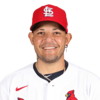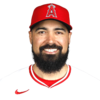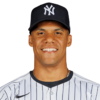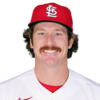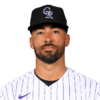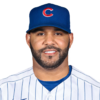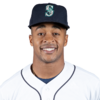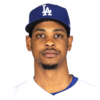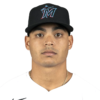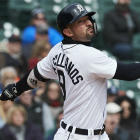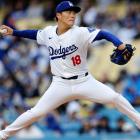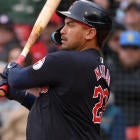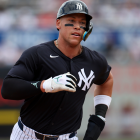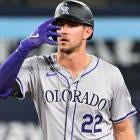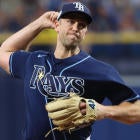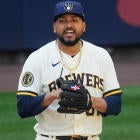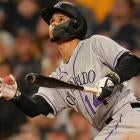Want to get a jump on the competition? Go to the CBS Sports app on your phone, open up "Settings" and sign up for Fantasy alerts to get the latest from our Fantasy baseball team as soon as it's available.
We maintain two sets of rankings here at CBS Sports, one for Head-to-Head leagues and one for Rotisserie.
It's kind of a pain, I'll admit.
What eases the burden a little is that the format doesn't drastically change the value for most players, at least not relative to others at the same position. Generally speaking, a good player is a good player, and his goodness permeates the entire Fantasy Baseball spectrum.
But there are certain players with certain qualities that make them uniquely suited for one format over the other.
The purpose of this piece is to identify those players, so that you might know them, and to highlight those qualities, so that you might discover more.
Please note these aren't intended to be the best possible lineups you could construct in these formats, which is why Mike Trout is in neither. They're merely the most representative of each format, comprised of the players you might go out of your way to draft specifically because you play in that format.
Please note also that by "Head-to-Head," I mean points-based, Fantasy Football-style scoring rather than category-based 5x5 scoring, which comes closer to Rotisserie in how players are valued and, therefore, would make this column unnecessary.
Let's get to it.
All-H2H team
Based on standard CBS Sports scoring:
| Head-to-Head point values | ||||||||
| For hitters | | For pitchers | | |||||
Single | 1 | Walk | -1 | |||||
Double | 2 | Earned run | -1 | |||||
Triple | 3 | Hit | -1 | |||||
Walk | 1 | Hit batter | -1 | |||||
Caught stealing | -1 | Inning | 3 | |||||
Hit by pitch | 1 | Strikeout | 0.5 | |||||
Home run | 4 | Win | 7 | |||||
Strikeout | -0.5 | Loss | -5 | |||||
Run | 1 | Save | 7 | |||||
RBI | 1 | QS | 3 | |||||
Stolen base | 2 | | | |||||
This format is the more straightforward one. No need to balance categories. Whatever a player produces is of benefit to you, regardless of what you already have, and the most productive players are the best, period. What makes it complicated is that virtually everything is worth something, as opposed to Rotisserie where you can concentrate on just a few different contributions. It allows you to win in the margins by targeting players who excel in the areas not normally rewarded, like hitting doubles, drawing walks avoiding strikeouts and, for pitchers, accumulating innings. In fact, pure accumulation is sort of the name of the game since percentage stats like batting average, ERA and WHIP have no direct value.
Catcher
At no position is the value of accumulation more evident than catcher, where physical demands can lead to a greater disparity in playing time, but Yadier Molina has remained a workhorse into his mid-30s. Playing regularly with good plate discipline will take a catcher far in this format, and that's certainly been true for Molina, whose power production has been hit or miss. His consistently low strikeout rate keeps him among the top performers, though, even when he doesn't hit 15-plus homers.
Honorable mention: Buster Posey, SF
First base
Perhaps no player has a bigger gap between his Head-to-Head and Rotisserie value than Santana, who consistently ranks among the league leaders in walks — and always with a near 1-to-1 strikeout-to-walk ratio — but lags in batting average, often severely. The former makes him a slam-dunk top 10 first baseman in Head-to-Head year after year, but the latter sometimes pushes him out of the top 20 in Rotisserie.
Honorable mention: Matt Carpenter, STL
Second base
Robinson Cano's Fantasy value is thought to have cratered during his time in Seattle, where his power took a notable step back, but there's still enough between the home runs and doubles, especially given his low strikeout rate, to elevate him to near-elite status in this format. Plus, he's a workhorse. About the only significant time he has missed was due to a PED suspension last year, and he still had the fourth-most Head-to-Head points per game at the position.
Honorable mention: Jeff McNeil, NYM
Third base
Though his batting average, RBI and runs scored always figure to be there, Rotisserie owners still have a hard time justifying an early-round pick in Anthony Rendon knowing his combined home run and stolen base total will likely be somewhere between 25 and 30. But he makes up for it in other ways in Head-to-Head points leagues, namely through a doubles surplus and uncommon ability to make contact. He actually outperformed Nolan Arenado in this format on a per-game basis last year.
Honorable mention: Justin Turner, LAD
Shortstop
I've already cited a number of hitters who excel in this format because of how little they strike out — there's so few true contact hitters in today's game that it's hard not to throw them all a parade — but Andrelton Simmons stands head and shoulders above the rest in that regard, having delivered the lowest strikeout rate in all of baseball last year. He does little else of note, which is why he's bottom of the barrel in Rotisserie leagues, but it took only 14 homers and 19 steals to move him into the top five shortstops in this format two years ago.
Honorable mention: Jurickson Profar, OAK
Outfield
Once again, plate discipline is the distinguishing factor for these hitters. Juan Soto's elevated ground-ball rate has led to some concern whether he can repeat last year's power numbers, but it won't so much matter in this format as long as he keeps walking nearly as often as he strikes out. Michael Brantley was the perfect example of a winning-in-the-margins-type player last year, having delivered the 11th-most Head-to-Head points per game at the position despite contributing only 17 homers and 12 steals, and Aaron Hicks was right behind him at 12th overall despite batting just .248. It meant fewer hits, sure, but he walked 90 times.
Honorable mentions: Rhys Hoskins, PHI; Jesse Winker, CIN; Nick Markakis, ATL
Starting pitcher
While strikeouts are a big deal for hitters in this format, they're not so much for pitchers. Sure, they help, but what they add to a pitcher's point total pales in comparison to what innings and wins can do — two interconnected contributions, it turns out. So naturally, workhorses who aren't known for their bat-missing abilities stand out in this format, with Miles Mikolas being the most obvious example. Rick Porcello's high-ish ERA is meaningless if he keeps throwing 200 innings and winning 15 games, and while Brad Keller's pitch-to-contact approach leads to a high WHIP, his extreme ground-ball tendencies greatly improve his run prevention, allowing him to throw six-plus innings with relative ease. There's no doubting Zack Greinke's ace credentials in this format, and Carlos Martinez, when healthy, is the best relief pitcher-eligible starting pitcher we've seen in years.
Relief pitcher
I mentioned Carlos Martinez as a SPARP, yes? The ability to use a starting pitcher as a relief pitcher can make a huge difference in this format, where pure innings accumulation will often separate even an average SPARP from a closer, and this year happens to be a great one for SPARPs. Brandon Woodruff has to win a rotation spot first, but he started the Brewers' first playoff game last year, making him worth a late flier in Head-to-Head leagues. Among closers, Wade Davis' ERA is a liability while pitching half his games in Colorado, but ERA has no direct value in Head-to-Head. Saves certainly do, and he's clearly in line for those.
All-Roto team
Based on standard 5x5 categories (BA, HR, RBI, R, SB for hitters and W, ERA, K, WHIP, SV for pitchers)
Rotisserie leagues aren't simply an exercise in assembling the best, most productive talent. You have to measure each player's individual contributions and strike the right balance across your entire roster. It's a quirk that leads to artificial scarcities, elevating a stat like stolen bases beyond its real-life utility. Thus, one-category specialists might have considerable value here when they'd be just an afterthought in Head-to-Head leagues.
Efficiency is of greater concern, particularly for pitching stats, where 40 percent of the focus is on ERA and WHIP. Innings can actually be a detriment, then, if provided by a middling talent who undoes much of the good work done by late-inning relievers.
Catcher
Certain batted-ball indicators suggest Jorge Alfaro has a big power ceiling, and if you project last year's numbers over the allotment of at-bats he figures to get in Miami, a 20-homer season is possible. It wouldn't matter in Head-to-Head leagues, where his strikeout rate would absolutely destroy him, but it could make him a nice find in this format.
Honorable mention: Mike Zunino, TB
First base
There were 10 players who contributed 20 homers and 20 steals last year, and — shocker — none of the others is eligible at first base. Ian Desmond is now a five-time entrant into the 20-20 club, and the scarcity of that diverse skill set will earn him some mid-round looks even though his inflated ground-ball rate and second-half slide are causes for concern.
Honorable mention: Joey Gallo, TEX
Second base
Steals! They're in short supply, and so anyone who shows a proclivity for them is sure to surge up the Rotisserie rankings. Jonathan Villar actually led the majors with 62 in 2016 and got back to running at a similar pace after getting traded to the Orioles midway through last season. He brings a risky profile that might get passed over completely in Head-to-Head leagues, but there aren't enough steals sources to be so cautious in Rotisserie.
Honorable mention: Rougned Odor, TEX
Third base
Though a high-contact hitter, it's the lack of walks that pulls down Andujar's Head-to-Head value. But making consistent contact also makes him a pretty safe bet for batting average, which apart from stolen bases may be the most difficult category to fill in Rotisserie leagues, particularly if you're not wanting to shortchange home runs. He's really handy in this format vs. just another guy in the other.
Honorable mention: Wil Myers, SD
Shortstop
Adalberto Mondesi is like Villar to the second power. Project his half-season numbers over a full season, and it comes out to like 25 homers and 60 steals, which is too uniquely helpful to pass up even acknowledging the risks posed by his poor plate discipline and spotty minor-league track record. The upside is impressive for Head-to-Head leagues, too, but you can afford to wait on him in a format that converts all those specialized contributions into a single point total.
Honorable mention: Garrett Hampson, COL
Outfielder
Once again, Starling Marte is to the All-Roto team what Carlos Santana is to the All-H2H, which is to say team captain. He rarely walks but usually excels in batting average and offers the steals that are so in demand. Nicholas Castellanos similarly doesn't excel at plate discipline but has the sort of line-drive rate that lends itself to a .290-plus batting average, a talent that wouldn't be directly rewarded in Head-to-Head leagues. Mallex Smith was one of just three players to steal 40 bases last year and also looks like he might help in batting average, but a lack of power limits his ceiling in Head-to-Head.
Honorable mentions: Lorenzo Cain, MIL; Victor Robles, WAS; Billy Hamilton, KC
Starting pitcher
Impact is the priority here. These five may not deliver the innings Head-to-Head owners are looking to see, but inning for inning, they'll be pure fire. That may be an overstatement for Masahiro Tanaka, but his tendency is to get pummeled on occasion, which might single-handedly wreck a Head-to-Head matchup, goes into a season-long stat pile in Rotisserie — one where he still figures to come out ahead in wins, WHIP and strikeouts. Alex Reyes and Jesus Luzardo are in basically the same place, having to win a rotation spot and contend with an innings limit, but getting pulled early won't be so damaging in this format if they're delivering in ERA and WHIP like they should.
Relief pitcher
Certainly, saves are a need in Rotisserie just like in Head-to-Head, but relievers can contribute in other ways in a format that rewards ratios (like ERA and WHIP) over totals (like innings). Hader was of course the best example from a year ago, delivering shutdown closer ratios over a bigger sample than the average reliever, but it was lost on owners who only want the saves, like in Head-to-Head. Will Smith, likewise, will have to fight for every save chance in San Francisco, where he may not even be the top ninth-inning option, but considering he was fifth among full-time relievers in FIP last year, he should matter in Rotisserie leagues regardless.







